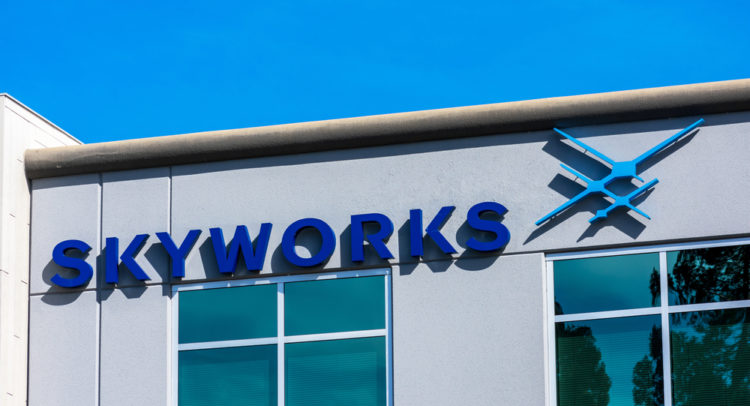There’s a definite split these days between primarily handset-driven RF semiconductor companies like Qorvo (QRVO) and Skyworks (SWKS) and more diversified companies like Analog Devices (ADI), Microchip (MCHP), and Texas Instruments (TXN), with the latter enjoying robust multiples relative to prior cycles as lead-times hit new highs. Meanwhile, despite strong 5G handset volume growth and margin uplift from higher-value content, multiples are not nearly so ambitious.
Elevate Your Investing Strategy:
- Take advantage of TipRanks Premium at 55% off! Unlock powerful investing tools, advanced data, and expert analyst insights to help you invest with confidence.
Rumors of meaningful content loss at Apple (AAPL) for Skyworks are likely just that – rumors. Moreover, the expansion of mid-band spectrum should create new RF content opportunities, while WiFi 6 continues to drive strong growth outside of the mobile business. Between double-digit free cash flow (FCF) growth prospects and non-GAAP operating margins in the high-30%’s, Skyworks should be trading for at least $200 per share and looks undervalued at current levels.
Mobile Isn’t Done Yet
Exceptional demand from mobile customers like Apple drove an amazing fiscal first quarter for Skyworks, with mobile revenue up 81% year-over-year and 79% quarter-over-quarter. Overall revenue beat expectations by a whopping 43% on the one-two punch of volume and content growth. Excluding the portion of Apple revenue that goes into the company’s “Broad Markets” segment, content likely grew around 20% to 25% (to around $10), with strong underlying volume growth driving most of the rest.
Handset volumes have always been erratic, and that fundamental reality is unlikely to change over the long-term, but expectations/worries of a near-term market peak seem a little misplaced. Skyworks management expects 5G handset volumes to nearly double in 2022 (from 250 million in 2020 to 400-500 million in 2021), and could double in the year after that as there are billions of users today who have a 3G or 4G phone.
Rumors that Skyworks could lose meaningful share to Qualcomm (QCOM) with the next generation of iPhones likewise seem overheated. At this point, there is no obvious motivation for Apple to make that switch, and if anything, Skyworks is likely looking at content growth in the near-term on increased use of mid-band frequencies (like C-band).
Longer-term, handset volume will slow and front-end suppliers like Skyworks and Qorvo will see more pressure on pricing – that’s just the nature of the cycle. Moreover, Skyworks still has some work to do with its offerings on the higher end of the frequency range, as this has not historically been an area of strength for the company. Given past bootstrap efforts (including its own in-house development of BAW filters), it seems reasonable to believe the company will do what it takes to remain competitive.
5G Can Unlock More Opportunities Outside Of Handsets
The 5G opportunity for Skyworks isn’t limited to just participation in RF components for handsets. The expansion of 5G also creates revenue opportunities in areas like massive MIMO, 5G small cells (power amplifiers, in particular), and indoor radios. 5G is also likely to drive significantly greater use of IoT, particularly industrial IoT, and this is an area where Skyworks is well-positioned.
In the shorter-term, Skyworks continues to generate the bulk of its Broad Markets revenue from its strong portfolio of IoT connectivity assets – WiFi in particular. This has largely been driven by consumer devices and smart home applications, with it boasting customers like Amazon (AMZN), Google (GOOGL), and Peloton (PTON). It should also be noted that WiFi 6 is driving a strong cycle across the space.
Longer-term, Skyworks has opportunities to leverage its broader array of connectivity assets (including BlueTooth, GPS, and ZigBee) into other markets like auto connectivity, industrial IoT, and industrial automation, as well as leveraging its core know-how in products like power amplifiers into new markets.
The Outlook
Some slowdown from the pace of the fiscal first quarter does seem likely, and FY’22 will likely see a step down in growth, but Skyworks’ 5G and IoT leverage should be able to drive long-term revenue growth in the high single-digits to low double-digits. It is also worth noting that Skyworks’ vertical integration is a relative advantage in this period of supply constraints for the industry.
Driving substantially higher operating margins is likely to be a slower process, though management does have a 40% long-term target, and adjusted FCF should outpace revenue growth (low-to-mid teens FCF growth over the long-term).
While revenue growth seems to be the predominant driver for most chip stocks now, historically, valuation is tied more to margin performance, and as chip supply shortages ease and lead-times shrink, that is likely to be the case again. Skyworks scores well here, with a near-term expected gross margin around 50% and an operating margin around 38% that can support a forward revenue multiple well above 5x.
Analysts Weigh In
As 11 Buys and 9 Holds have been assigned in the last three months, the consensus rating is a Moderate Buy. At $204.38, the average analyst price target implies 9% upside potential. (See Skyworks stock analysis on TipRanks)

The Bottom Line
Distinguishing between “cheap” and “cheap for a reason” is important in making good long-term investment decisions. In the case of Skyworks, while there are some potential issues (weaker handset volumes, content losses), the magnitude of the concern seems outsized relative to the likelihood. Accordingly, Skyworks shares look undervalued below $200 and have upside well beyond that.
Disclosure: Stephen Simpson held no position in any of the stocks mentioned in this article at the time of publication.
Disclaimer: The information contained herein is for informational purposes only. Nothing in this article should be taken as a solicitation to purchase or sell securities.















